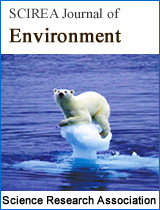PREDICTION OF LAND EROSION IN THE CATCHMENT AREA OF THE DELINGAN RESERVOIR USING USLE AND MUSLE METHODS
DOI: 10.54647/environmental61328 94 Downloads 92369 Views
Author(s)
Abstract
Tirtomarto reservoir or their people call it the Delingan reservoir because of its location in the village of Delingan, Karanganyar District, Karanganyar Regency, Central Java Province in Indonesia, it has an important role in meeting irrigation needs for agricultural land covering area of 1380 ha every year, but over time the Delingan reservoir is now visible. experienced a decrease in its water capacity and resulting in a decrease in water supply for agricultural land. This is due to the large value of land erosion that occurs. This study aims to calculate the value of land erosion that occurs in the catchment area of the Delingan reservoir which can later be handled so that sedimentation in the reservoir can be overcome and the water supply is maintained. Prediction of soil erosion in this study using the USLE (Universal Soil Loss Equation) and MUSLE (Modified Universal Soil Loss Equation) methods. The results of this study obtained the value of the erodibility factor of rain (R) from 2015-2019, the soil erodibility factor (K) of 0.04, the length and slope factor (LS) of 1.991134206, the factor of land cover plants and the factor of conservation measures. (CP) of 0.035456901. In the USLE method, the erosion value is 7605.891488 tons/year. Then the maximum flood discharge value (QP), surface runoff (QQ), and surface runoff (R) can be obtained so that the erosion value using the MUSLE method is 862.88 tons/year.
Keywords
erosion, sedimentation, USLE, MUSLE
Cite this paper
Jaji Abdurrosyid, Fathul Ngalim, Renaningsih, Agus Riyanto, Gotot Slamet Mulyono,
PREDICTION OF LAND EROSION IN THE CATCHMENT AREA OF THE DELINGAN RESERVOIR USING USLE AND MUSLE METHODS
, SCIREA Journal of Environment.
Volume 7, Issue 1, February 2023 | PP. 1-14.
10.54647/environmental61328
References
| [ 1 ] | Abdurrosyid, Jaji. 2003. “Sediment Transport”, Textbook, Ed.1 Muhammadiyah University Press, Surakarta. |
| [ 2 ] | Adhiani, Chamalia, 2019. "Spatial Analysis of the Erosion Rate of the Lempake Reservoir in East Kalimantan Province". Thesis. Surakarta: Faculty of Geography, Muhammadiyah University of Surakarta. |
| [ 3 ] | Annisa, F.Y., 2020. “The Effect of Land Use Chamge On The Cengklik Dam Sedimentation Rate”. Thesis. Surakarta: Muhammadiyah University of Surakarta. |
| [ 4 ] | Anonimous, 2000, “Master Plan Bengawan Solo River”, Proyek Wilayah Sungai (PWS) Bengawan Solo, Departemen Pekerjaan Umum. |
| [ 5 ] | Alie, M.E.R., 2015. "Study of Land Erosion in the Dawas Watershed, Musi Banyuasin Regency - South Sumatra". e-Jurnal of Civil and Environmental Engineering, Vol 3, No 1 (2015). |
| [ 6 ] | Dewi, I.A.S Utami et al. 2012. "Erosion Prediction and Soil and Water Conservation Planning in the Saba River Basin". e-Journal of Tropical Agroecotechnology, Vol 1, No (2012). |
| [ 7 ] | Adriani, Annisa Fitria. 2014. "Analysis of Erosion Levels and Land Criticality Using Geographic Information Systems in Bengkulu Downstream Watershed Air Bengkulu". Thesis. Bengkulu: Faculty of Engineering, University of Bengkulu. |
| [ 8 ] | Fauzi, Zulfa, 2016. “Study of Erosion and Sediment Results for Upstream Kreo Watershed Land Conservation”. Journal of Regional and City Development, Vol 12, No 4 (2016): 429-445. |
| [ 9 ] | Krisnayanti, D.S., et al, 2018. "Erosion and Sedimentation Estimation Using the USLE and MUSLE Methods in the Nuel-Puames Watershed". Journal of Civil Engineering, Vol 7, No 2 (2018). |
| [ 10 ] | Mekarsari, Rindang and Praise, 2019. "Analysis of Erosion Hazard Levels in Wadaslintang Reservoir with ArcGIS Applications". Journal of Geography Gea, Vol 19, No 2 (2019). |
| [ 11 ] | Muntiani, A.A, et.al., 2019. "The Impact of Agricultural Activities in the Delingan Reservoir Bonoworo Area on the Preservation of Reservoir Functions". Proceedings of National Seminar V 2019. ISBN 978-602-5699-83-2. |
| [ 12 ] | Rohmaniyah, Inayah, 2016. "Analysis of Erosion Rates and Sedimentation of the Wadaslintang Reservoir in Central Java Province". Thesis. Jakarta: Faculty of Engineering, Jakarta State University. |
| [ 13 ] | Sundar, Riska, 2017. “Analysis of Erosion and Sedimentation of the Mrica Banjarnegara Dam”. Thesis. Yogyakarta: Faculty of Engineering, Muhammadiyah University of Surakarta. |

